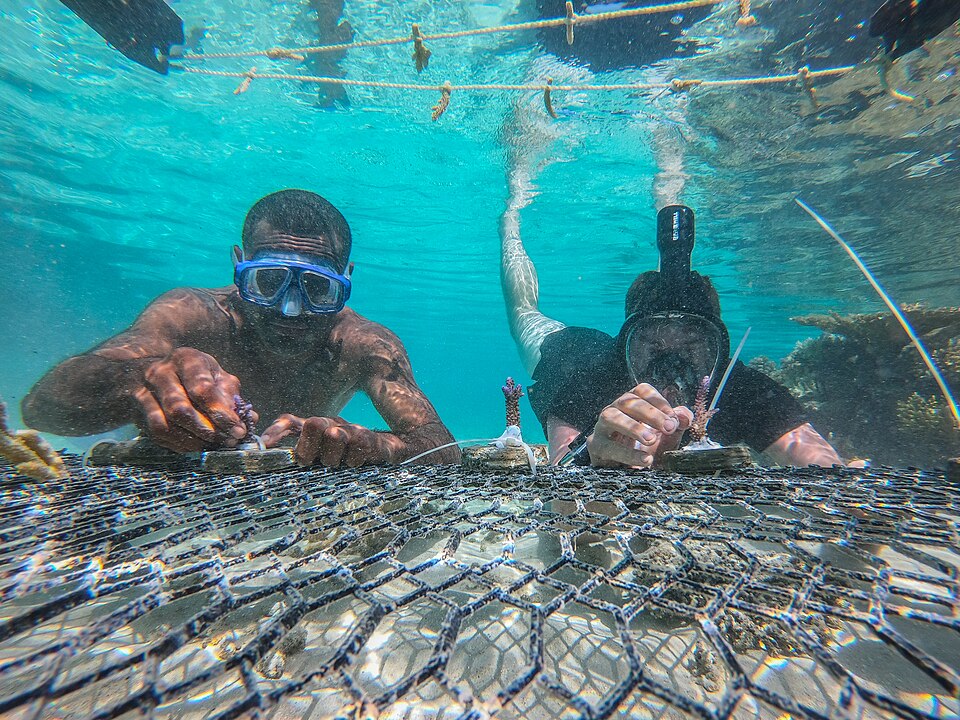Rainforests of the ocean
Coral reefs are a marine habitat with incredible biodiversity. Although coral reefs cover only 0.1% of the Earth’s surface, it is home to about a quarter of all marine species. The diversity of coral reefs means that they are sometimes referred to as the rainforests of the ocean. Many species of fish, crustaceans, cnidarians, sponges, worms, molluscs, echinoderms, sea squirts – and even some reptiles and mammals – live all or part of their lives here. A coral reef offers lots of hiding places and ways of life, and the organisms that live here come in all sizes, from microscopically small crustaceans to large sharks or giant clams.
About a quarter of all marine species live in coral reefs.
Photo: Toby-Hudson-CC-BY-SA
Among the incredible diversity found in a coral reef, one can discover pygmy seahorses that look exactly like the coral they inhabit.
Photo: Rickard-Zerpe-CC-BY-SA
There are not only fish in a coral reef; several reptiles, such as sea turtles, depend on coral reefs for their survival.
Photo: Bernard-DUPONT-CC-BY-SA
In a coral reef, there are numerous hiding places, food sources, and habitats.
Photo: Nick-Hobgood-CC-BY-SA
Made up of limestone
A coral reef is built up over thousands of years, by the corals that live in it. Stony corals is the group that forms the framework of a reef. It is a colony of small animals called polyps. Together, the polyps build up a hard skeleton of limestone, which they make from calcium and carbonates that they extract from seawater. The skeletons remain even after the coral animal itself has died, and over time a reef is formed, of corals and other calcareous organisms that are stacked on top of each other, perhaps with rocks or boulders or rocks as a foundation. Corals can grow very slowly – and it takes an incredibly long time to build a large coral reef.
Stony corals, also known as hard corals, are the group of corals that lay the foundation for coral reefs by building skeletons from calcium in seawater.
Photo: Williams-et-al.-CC-BY
An atoll is a ring-shaped island formed when corals begin to grow around a volcano that has later sunk into the sea. Coral reefs can create various geological formations in nature.
Photo: NASA-Astronaut-Image-Public-Domain
Coral debris, or coral sand, is the dead skeletal remains of stony corals that have washed up on the shore or ended up at the bottom of the sea.
Photo: mariemon-CC-BY-SA
Coral reefs that eventually petrify and emerge from the sea can be found as fossilized limestone formations in many places where coral reefs once existed. The cliff in the picture is from Taiwan, but fossilized coral reefs can also be found in Sweden, dating back to times when Sweden was closer to the equator.
Photo: I-Chung-Hu-C-BY-SA
The Great Barrier Reef is the world's largest and perhaps most well-known continuous coral reef. The reef is located off the northeast coast of Australia.
Photo: Jeff-Schmaltz-MODIS-Land-Rapid-Response-Team-NASA-GSFC-Public-Domain
Barrier reefs are vital formations, serving as both a natural resource with their biological diversity and as protection against storms or tsunamis approaching the land. In such cases, the reef helps slow down the impact. Here is a barrier reef off the coast of New Caledonia.
Photo: NASA-Earth-Observatory-Public-Domain
Important protection for people
In addition to being a vital environment for many species, the coral reef also fulfils many other functions, which are important for the earth and us humans. Almost half a billion people are wholly or partly dependent on coral reefs for food and livelihoods, for example through fishing and tourism. Many also depend on coral reefs for protection. When storms or tsunamis approach coastal communities, coral reefs are very important in slowing the effect on land. In addition, scientists have been able to find many substances from organisms in coral reefs, which can be used in human medicine. Medicines to treat, for example, cancer, cardiovascular diseases, bacterial infections and stomach ulcers have been manufactured using chemical substances in coral reef animals and plants.
Coral bleaching in Hawaii is being studied by researchers.
Photo: Caitlin-Seaview-Survey-Public-Domain
When the ocean warms up, the algae living in symbiosis with corals die. As the algae die, only the coral's white limestone skeleton remains visible. The corals then lose their main source of energy and eventually die.
Photo: Matt-Kieffer-CC-BY-SA
Climate change and environmental degradation
Unfortunately, coral reefs are one of the most endangered ecosystems on Earth. Over the past 150 years, half of the world’s coral populations have disappeared, and if the destruction is not slowed down, the world’s tropical coral reefs could be completely wiped out by 2050. The reasons for the destruction of coral reefs are many, but all of them can be summarised as originating from: Man.
Climate change is a major threat to coral reefs. As the oceans warm, corals die in a process known as coral bleaching. The increased emissions of carbon dioxide also make the oceans more acidic – which makes it more difficult for corals to build their calcareous skeletons. Unsustainable fishing and tourism are also a major threat to coral reefs. In some places, very harmful fishing methods are used, such as trawling, dynamite fishing or fishing with the poison cyanide – which risks destroying entire ecosystems. Emissions of environmental toxins, sludge and sediment that enter the sea via rivers are also a major problem for corals – which are sensitive to change and are easily outcompeted by unnatural algae growth.

What can I do?
-Get involved in organisations that work for the protection and conservation of coral reefs, such as the World Wide Fund for Nature (WWF).
-Vote for, or get involved with parties that want to stop climate change and environmental degradation.